|
In last month's issue of Scene4, Renate Stendhal captured San Francisco Ballet's performance of John Neumeier's misogynist mermaid tale (see archives) which is based loosely after Hans Christian Andersen. However, I wanted to add a few additional thoughts. First, it's important to acknowledge the enormous investment of resources that went into this production, including the physical and psychological strain endured by the dancers. Artistic Director Helgi Tomasson will never be known for the experimentation he brings to his own prosaic choreography but he will be remembered for the creativity and daring he brings to the War Memorial Opera House stage through his programming of other leading choreographers including the likes of American-born and Germany-based John Neumeier.
Neumeier's Little Mermaid is operatic in its scale including the use of stage design, lighting and costumes, all credited to the choreographer. It is a high-concept theatrical experience that utilizes technology to create neon waves as well as old-fashioned steamer furniture to create the nautical atmosphere. The extravagant costumes are rendered with exactitude to create vivid, if over-crowded, underwater scenes and on-deck verisimilitude. Incorporating ideas he gleaned from Japanese Noh theatre, Neumeier costumed the mermaids in beautifully crafted wide-legged pants that extended several feet below their ankles. This concept worked. Another trick Neumeier borrowed from Noh traditions was to dispatch three black-clad footmen to the stage to carry the mermaids around while they simulated swimming. After the initial impact of this clever devise its overuse diminished it to a distracting cliché. All of those bodies and all of that fabric became a focal point as the performers labored to avoid calamity.
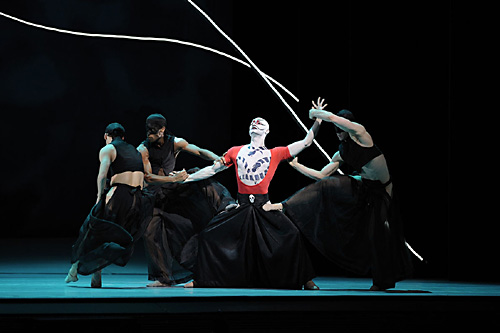 |
In creating Little Mermaid, Neumeier chose as his theme the unrelenting suffering caused by unrequited love. To embody this theme he chose the dual and symbiotic characters of the Poet and the Mermaid. The archetype of the suffering poet who longs for an unattainable ideal is familiar, if not also clichĂ©; Neumeier's rendering is not sufficiently nuanced or developed to justify such long and ultimately monotonous torment. Neumeier worked that theme until we all suffered the agony of longing—to leave the theatre and wash the horror show from our memories. Only in the final moments of the indefensibly long and repetitive piece did he give a glimpse of the Poet's other dimensions as a feeling person.
What a shame that Neumeier didn't have a trusted friend or colleague to tell him that his Little Masterpiece had become a bloated whale. If this mythical conversation with a trusted mentor had taken place, the nearly two-and-a-half hours might have been edited down to a coherent rendering. Questions could have been asked about why this piece required ballet dancers at all. There is so little dancing that the dancers are asked to do what they have not been trained to do. Hard as they tried in San Francisco, it became painfully obvious that this work should be set on actors who can move rather than dancers who can barely act.
Our mythical mentor and trusted friend could have taken on the role of benevolent psychologist and asked Neumeier if he hadn't perhaps gone overboard in his relentless humiliation of the Mermaid. Why was it necessary to actualize on stage for all to see the depth's of Neumeier's hatred toward women? Did Neumeier believe that the full-color violence and celebration of inflicted physical pain would shock the audience into buying into his vision of art and gloss over the underlying psychological meaning? Was it truly advisable to manipulate the audience and betray their trust with the cynical assumption that they would ignore their feelings of horror and disgust in favor of believing that Neumeier couldn't possibly be a misogynist masquerading as an artist?
San Francisco Ballet's audience is loyal to its dancers and it appreciates their hard work. The next time Helgi Tomasson is tempted to devote such resources to staging a San Francisco premiere, let's hope he gives the audience more credit than John Neumeier did.
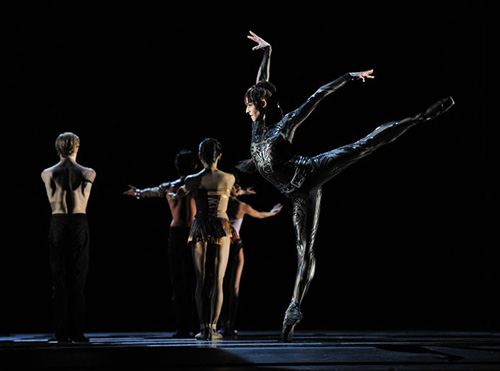 |
As if to make it up to the dancers, Tomasson did present two smaller scale world premieres in the programs that immediately followed Little Mermaid. Underskin created by choreographer Renato Zanella gave the dancers a chance to do what they love: perform interesting and challenging choreography that allows them to push their bodies in new directions. Sophiane Sylve appeared to be having the time of her life whipping her long limbs around the stage clad in a body suit that resembled a full-body tattoo. She is a temperamental dancer who, like many French dancers, cannot always hide her mood from the audience. In this instance, it worked to her benefit. She was energized and excited, she wanted the audience to feel her pleasure as she led the larger group of three couples and eight corps dancers. Even when she left the stage, she ensured that the audience was still thinking about her, waiting for her to return.
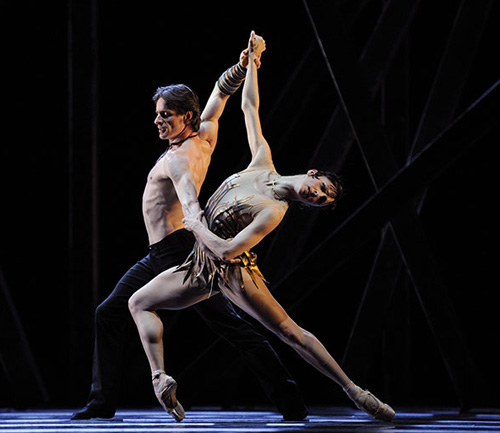 |
Zanella worked with Anne Marie Legenstein to create both the set and costumes which were meant to evoke a forest as the symbol of the soul. Set to Arnold Schoenberg's Verklarte Nacht, one of his early works that predates his experimentation with atonality, the feel was dark and mysterious but not menacing. Costumes included laced-up vests, heavy leather belts and various other paraphernalia of the leather crowd and seemed to give the dancers a buzz of edginess. The dancers appeared and disappeared through layers of scrim and around giant vertical pick-up sticks meant to represent trees.
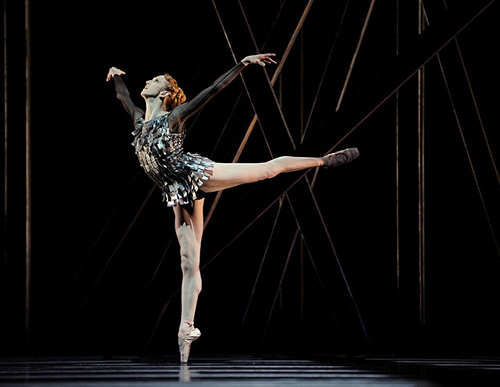 |
Frances Chung, in her first full season as principal dancer, was commanding and precise, beautifully partnered by the powerful though not always demonstrative Gennadi Nedvigin. Lorena Feijoo and Pascal Molat brought daring and risk to their counterweight balances and off-center lifts. Appearing in one of her last performances after a 23-year career at San Francisco Ballet, Katita Waldo danced with passion as her partner, Victor Luiz, made space for her to enable the audience to burn images of her into their memories.
The second premiere, Classical Symphony, presented near the end of the season, was created by resident choreographer and former principal dancer, Yuri Possokhov. Set to Sergei Prokofiev's first symphony, this is a demanding work for the dancers to perform and a satisfying work of neo-classicism to regard. Costumes by Sandra Woodhall, simple tutus featuring a space-age, sharp-angled disk for a skirt, added to the clean precision of the overall look.
Possokhov brings an unparalleled set of skills and depth of experience into the studio when he creates. From his years of training and performance experience with the Bolshoi Ballet in Moscow to his lengthy career as a principal dancer at San Francisco Ballet he draws upon a singularly rich imagination as well as deep knowledge of what dancers can, or more importantly, might do. In rehearsal he is said to sometimes be moody and brooding, particularly demanding of himself, as he desires to constantly break new ground and deliver startling images of great beauty. His process involves lots of experimentation as he puts the dancers into unusual positions and combinations and surprises them by resolving these puzzles with unexpected solutions.
His work for the male dancers is particularly exciting. In addition to being expected to serve in the usual role as support for the female dancers as they turn multiple pirouettes and stretch into lengthy extensions, he also asks the men to produce great feats of technical prowess.
Possokhov was a powerful performer who, due to his Russian training and decades of hard work, demonstrated at the peak of his career a rarely seen level of technical ability. How satisfying it must be for him, now that he is beyond his performing years, to give these tasks to the eager, younger dancers and see his ideas come to life without having to suffer the physical consequences. Jaime Garcia Castilla, Daniel Deivison and Hansuke Yamamoto are particularly willing and able dancers who brought youthful bounce and power to the choreography. One could imagine Possokhov in rehearsal being encouraged by their enthusiasm and ability and demanding more and more of each of them. Garcia Castilla has very long legs and a short torso, the ratio normally expected of female dancers, and his extreme flexibility and fluidity are also somewhat feminine. His pliant bounce and the great height of his jumps were beautifully emphasized by Possokhov's tricky choreography.
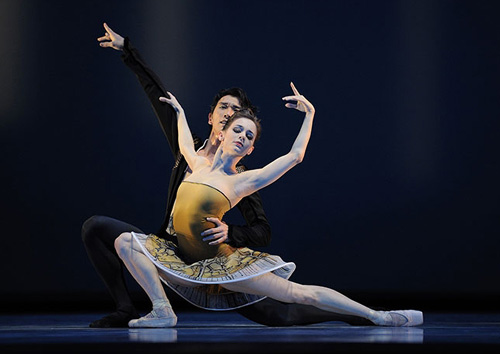 |
The real star of this work, however, is Maria Kochetkova, Possokhov's compatriot who was also trained by the Bolshoi. He seemed to ask the most of her and she delivered. Her multiple pirouettes were razor sharp—in fact, she seemed better able to balance and rotate with precision on her own than when partnered by Yamamoto. Possokhov asked the near impossible of her at times but she appeared pleased by her ability to deliver. One particularly difficult sequence involved her spinning like a top as she extended one leg and dropped almost to the floor before rising to her full height again. Possokhov tosses these breathtaking flourishes onto the otherwise still stage and then resumes the action with a flood of movement. He truly understands how to create drama by keeping the dancers and audience a bit off-balance.
All photos are courtesy of San Francisco Ballet, © Erik Tomasson
|



